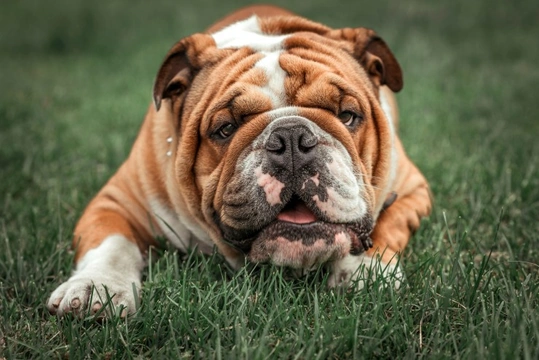
Skin fold dermatitis in the English Bulldog
The English bulldog is of course a hugely popular dog breed here in the UK, and these loyal, laid back dogs are excellent companions for people from all walks of life that want a loving, slow-moving companion that enjoys sedate walks and long evenings chilling out on the couch.
However, the English bulldog is also a breed that as a whole, suffers from more hereditary health problems and congenital defects than most other breeds, and this is particularly true for dogs of the breed that have been selectively bred for exaggerations such as a very flat face, a very stocky, squat appearance, and very wrinkled, loose skin.
This latter trait – loose, wrinkly skin with lots of skin folds around the face and body – can easily lead to the development of a condition called skin fold dermatitis, which can make your dog itchy, uncomfortable and irritated, as well as potentially leading to infections of the skin and other issues.
Whatever type of English bulldog you own or are considering buying – but particularly if your dog has very loose, wrinkled skin and lots of facial folds – it is important to learn about skin fold dermatitis, how it can affect bulldogs, and how to prevent it from occurring.
In this article, we will look at skin fold dermatitis in the English bulldog in more detail, including how it occurs, how to treat it, and how to prevent it. Read on to learn more.
What is skin fold dermatitis?
Dermatitis is a catch-all title that refers to irritations and/or inflammation of the skin, and so of course skin fold dermatitis is an irritation, inflammation (or potentially, infection) that develops in the creases of the dog’s skin folds, which can make it hard to spot and identify, because it is normally well hidden.
Skin fold dermatitis arises when moisture, dirt, shed skin cells, hair or grease and other debris like food collect within the creases of the dog’s skin. Any foreign bodies like grit within the skin folds will rub and irritate your dog, as well as clogging the pores and making your dog’s skin sore, but even damp or moisture within skin folds that are scrupulously clean can have the same effect.
Additionally, dirty or moist skin folds serve as a perfect breeding ground for bacterial and fungal infections, which adds another layer to the problem.
What sort of English bulldogs are at risk of developing skin fold dermatitis?
Any dogs with lots of loose, wrinkled skin can develop skin fold dermatitis, which encompasses many other dog breeds as well as the English bulldog. However, because skin folds are a breed trait of all English bulldogs, particularly around the face, the breed as a whole is more prone to problems of this type than most.
That said, English bulldogs that don’t have highly exaggerated flat faces and that are bred to be rather leaner, potentially taller and less squat and wrinkled than many people prefer are at least risk of having problems of any variety – whilst dogs bred for lots of wrinkles are those most in danger of suffering from skin fold dermatitis.
Caring for your English bulldog’s skin folds
Before you buy or adopt an English bulldog, it is really important to ensure that you know what you are getting into, and that you understand the unique care requirements of the breed in terms of their general health and health problems, and specific issues such as skin fold dermatitis.
Caring for your English bulldog’s skin folds can help to prevent problems from developing and keep your dog comfortable, which means that you should clean and thoroughly dry the creases regularly, which for dogs that tend to suffer from skin fold dermatitis or that are very wrinkled, may mean doing so a couple of times a day.
You should part the skin folds right down to the crease and thoroughly clean inside of the folds, removing any muck or debris and checking for signs of congestion or irritation. Ensure that you dry the skin properly as well, because moisture can cause rubbing as well as increasing the risks of a fungal or bacterial infection developing.
Identifying the symptoms of skin fold dermatitis
When you clean and check your dog’s skin folds, look out for problems such as soreness, inflammation, hotspots, irritation, redness and spots or congestion. Also, if you notice that your dog’s skin folds seem to develop a residue or strange covering even when clean, they may have a fungal infection present, and bacterial infections too can lead to weeping, soreness and irritation and discomfort.
If your dog appears reluctant to let you clean and check their skin folds, this may be because it is painful or irritating, which means you will need to make an extra effort to check, or if you can’t manage it alone, talk to your vet.
One other thing to note is that if your dog’s skin folds smell either foul or unusual – such as a cheesy smell – this can also indicate an infection present.
Treatment options
If your dog’s skin folds have a fungal or bacterial infection present, your vet will need to prescribe a medicine or cream to treat this, alongside of ensuring that you keep the skin folds scrupulously clean and dry.
If there is no infection present but your dog’s skin appears sore or irritated, again, keeping it clean and dry may be sufficient to reverse the problem, but you may again need to talk to your vet about a cream to promote healing and reduce any irritation or discomfort.



